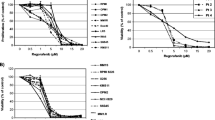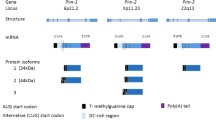Abstract
Multiple myeloma (MM) is a uniformly fatal disorder of B cells characterized by the accumulation of abnormal plasma cells. Phosphoinositide 3-kinase (PI3K) signaling pathways play a critical regulatory role in MM pathology. Copanlisib, also known as BAY80-6946, is a potent PI3Kα and δ inhibitor. In this study, we investigated the efficacy of copanlisib and a proteasome inhibitor using MM cell lines and primary samples. The p110α and δ catalytic subunits of the class PI3K increased, and carfilzomib activity reduced in the presence of a supernatant from the feeder cell line, HS-5. Phosphorylation of Akt and activation of caspase 3 and poly (ADP-ribose) polymerase (PARP) partially reduced upon carfilzomib treatment in the presence of HS-5. Apoptosis also decreased. Copanlisib treatment for 72 h inhibited growth in MM cell lines and induced apoptosis. Combination treatment of MM cells with carfilzomib and copanlisib caused greater cytotoxicity than that caused by either drug alone and increased apoptosis. Caspase 3 activity increased while that of Akt decreased after combination treatment with copanlisib and carfilzomib. Further, copanlisib inhibited vascular endothelial growth factor (VEGF)-mediated angiogenesis in vitro and in vivo. It also inhibited C-X-C motif chemokine 12 (CXCL12)-mediated chemotaxis. The data suggest that administration of the PI3K inhibitor, copanlisib, may be a powerful strategy against stroma-associated drug resistance of MM cells and can enhance the cytotoxic effects of proteasome inhibitors in such residual MM cells.





Similar content being viewed by others
References
Kuehl WM, Bergsagel PL (2012) Molecular pathogenesis of multiple myeloma and its premalignant precursor. J Clin Invest 122:3456–3463
Smith D, Yong K (2013) Multiple myeloma. BMJ 346:f3863
Moreau P, Attal M, Facon T (2015) Frontline therapy of multiple myeloma. Blood 125:3076–3084
Nooka AK, Kastritis E, Dimopoulos MA, Lonial S (2015) Treatment options for relapsed and refractory multiple myeloma. Blood 125:3085–3099
Gao M, Kong Y, Yang G, Gao L, Shi J (2016) Multiple myeloma cancer stem cells. Oncotarget 7:35466–35477
Iida S (2016) Mechanisms of action and resistance for multiple myeloma novel drug treatments. Int J Hematol 104:271–272
Naymagon L, Abdul-Hay M (2016) Novel agents in the treatment of multiple myeloma: a review about the future. J Hematol Oncol 9:52
Engelman JA (2009) Targeting PI3K signalling in cancer: opportunities, challenges and limitations. Nat Rev Cancer 9:550–562
Vanhaesebroeck B, Whitehead MA, Piñeiro R (2016) Molecules in medicine mini-review: isoforms of PI3K in biology and disease. J Mol Med (Berl) 94:5–11
Liu N, Rowley BR, Bull CO, Schneider C, Haegebarth A, Schatz CA, Fracasso PR, Wilkie DP, Hentemann M, Wilhelm SM, Scott WJ, Mumberg D, Ziegelbauer K (2013) BAY 80-6946 is a highly selective intravenous PI3K inhibitor with potent p110α and p110δ activities in tumor cell lines and xenograft models. Mol Cancer Ther 12:2319–2330
Okabe S, Tauchi T, Tanaka Y, Sakuta J, Ohyashiki K (2015) Efficacy of the polo-like kinase inhibitor rigosertib, alone or in combination with Abelson tyrosine kinase inhibitors, against break point cluster region-c-Abelson-positive leukemia cells. Oncotarget 6:20231–20240
Bisping G, Kropff M, Wenning D, Dreyer B, Bessonov S, Hilberg F, Roth GJ, Munzert G, Stefanic M, Stelljes M, Scheffold C, Müller-Tidow C, Liebisch P, Lang N, Tchinda J, Serve HL, Mesters RM, Berdel WE, Kienast J (2006) Targeting receptor kinases by a novel indolinone derivative in multiple myeloma: abrogation of stroma-derived interleukin-6 secretion and induction of apoptosis in cytogenetically defined subgroups. Blood 107:2079–2089
Xu S, Menu E, De Becker A, Van Camp B, Vanderkerken K, Van Riet I (2012) Bone marrow-derived mesenchymal stromal cells are attracted by multiple myeloma cell-produced chemokine CCL25 and favor myeloma cell growth in vitro and in vivo. Stem Cells 30:266–279
Roecklein BA, Torok-Storb B (1995) Functionally distinct human marrow stromal cell lines immortalized by transduction with the human papilloma virus E6/E7 genes. Blood 85:997–1005
Kumar S, Fonseca R, Dispenzieri A, Lacy MQ, Lust JA, Wellik L, Witzig TE, Gertz MA, Kyle RA, Greipp PR, Rajkumar SV (2003) Prognostic value of angiogenesis in solitary bone plasmacytoma. Blood 101:1715–1717
Bellamy WT, Richter L, Frutiger Y, Grogan TM (1999) Expression of vascular endothelial growth factor and its receptors in hematopoietic malignancies. Cancer Res 59:728–733
Spencer A, Yoon SS, Harrison SJ, Morris SR, Smith DA, Brigandi RA, Gauvin J, Kumar R, Opalinska JB, Chen C (2014) The novel AKT inhibitor afuresertib shows favorable safety, pharmacokinetics, and clinical activity in multiple myeloma. Blood 124:2190–2195
Ghobrial IM, Siegel DS, Vij R, Berdeja JG, Richardson PG, Neuwirth R, Patel CG, Zohren F, Wolf JL (2016) TAK-228 (formerly MLN0128), an investigational oral dual TORC1/2 inhibitor: a phase I dose escalation study in patients with relapsed or refractory multiple myeloma, non-Hodgkin lymphoma, or Waldenström's macroglobulinemia. Am J Hematol 91:400–405
Mimura N, Hideshima T, Shimomura T, Suzuki R, Ohguchi H, Rizq O, Kikuchi S, Yoshida Y, Cottini F, Jakubikova J, Cirstea D, Gorgun G, Minami J, Tai YT, Richardson PG, Utsugi T, Iwama A, Anderson KC (2014) Selective and potent Akt inhibition triggers anti-myeloma activities and enhances fatal endoplasmic reticulum stress induced by proteasome inhibition. Cancer Res 74:4458–4469
Sahin I, Azab F, Mishima Y, Moschetta M, Tsang B, Glavey SV, Manier S, Zhang Y, Sacco A, Roccaro AM, Azab AK, Ghobrial IM (2014) Targeting survival and cell trafficking in multiple myeloma and Waldenstrom macroglobulinemia using pan-class I PI3K inhibitor, buparlisib. Am J Hematol 89:1030–1036
Zhu J, Wang M, Yu Y, Qi H, Han K, Tang J, Zhang Z, Zeng Y, Cao B, Qiao C, Zhang H, Hou T, Mao X (2015) A novel PI3K inhibitor PIK-C98 displays potent preclinical activity against multiple myeloma. Oncotarget 6:185–195
Doi T, Fuse N, Yoshino T et al (2014) Phase I study of intravenous PI3K inhibitor BAY 80-6946 in Japanese subjects. Cancer Res 73(8 supplement):29-29
Larson SM, Peng MY, Mead M et al (2017) Inhibition of PI3K alpha and PI3K delta with copanlisib shows preclinical activity as a single agent and in combination in multiple myeloma. Blood 130:3084
Acknowledgments
We thank the Tokyo Medical University Research Center for providing technical support.
Funding
This work was supported by a High-Tech Research Center Project for private universities, a matching fund subsidy from the Ministry of Education, Culture, Sports, Science, and Technology (MEXT), and by the University-Industry Joint Research Project for private universities (another matching fund subsidy from MEXT). This work was also supported by grants-in-aid for Scientific Research from MEXT and Supporting Positive Activities for Female Researchers. In addition, the study was supported by a grant from the Bristol-Myers Squibb Company.
Author information
Authors and Affiliations
Contributions
Conception and design: S Okabe, Y Tanaka, T Tauchi, and K Ohyashiki. Development of methodology: S Okabe, Y Tanaka, T Tauchi, and K Ohyashiki. Acquisition of data (provided animals, acquired and managed patients, provided facilities, etc.): S Okabe, Y Tanaka, and T Tauchi. Analysis and interpretation of data (e.g., statistical analysis, biostatistics, computational analysis): S Okabe, Y Tanaka, and T Tauchi. Writing, review, and/or revision of the manuscript: S Okabe, Y Tanaka, T Tauchi, and K Ohyashiki. Administrative, technical, or material support (i.e., reporting or organizing data, constructing databases): S Okabe, Y Tanaka, T Tauchi, and K Ohyashiki.
Corresponding author
Ethics declarations
This study protocol was approved by the Institutional Review Board of the Tokyo Medical University (No. 1974, H-28026).
Conflict of interest
The authors declare that they have no conflicts of interest.
Electronic supplementary material
Supplemental Fig. 1
Carfilzomib efficacy was decreased by the HS-5 supernatant. (a) U266 and RPMI8226 cells were co-cultured with or without HS-5 and treated with the indicated concentration of carfilzomib for 72 h. Percentage cell growth was determined. *P < 0.05 compared to control. Results represent three separate experiments. (PNG 220 kb)
Supplemental Fig. 2
Efficacy of copanlisib and carfilzomib in myeloma cells. (a, b) U266 or RPMI8226 cells were treated with the indicated concentrations of carfilzomib or bortezomib and/or copanlisib for 72 h. The relative cytotoxic rates were determined. (PNG 1120 kb)
Supplemental Fig. 3
Efficacy of PI3K isoform-specific inhibitors and carfilzomib in myeloma cells. (a) RPMI8226 cells were treated with carfilzomib and/or pictilisib, alpelisib, idelalisib, and carfilzomib with alpelisib plus idelalisib for 72 h, after which relative cell growth rates were determined. The data shown represent three independent experiments. *P < 0.05, compared with alpelisib or idelalisib treatment. (PNG 186 kb)
Rights and permissions
About this article
Cite this article
Okabe, S., Tanaka, Y., Tauchi, T. et al. Copanlisib, a novel phosphoinositide 3-kinase inhibitor, combined with carfilzomib inhibits multiple myeloma cell proliferation. Ann Hematol 98, 723–733 (2019). https://doi.org/10.1007/s00277-018-3547-7
Received:
Accepted:
Published:
Issue Date:
DOI: https://doi.org/10.1007/s00277-018-3547-7




